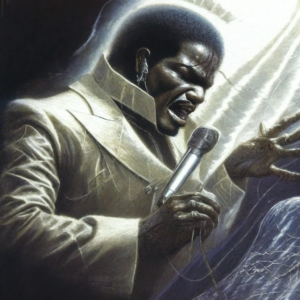Introduction
Otis Redding, a name synonymous with soulful melodies and heartfelt performances, stands as an iconic figure in the landscape of American music. Born on September 9, 1941, in Dawson, Georgia, Redding’s journey from humble beginnings to becoming one of the greatest soul singers of all time is a testament to his undeniable talent and unwavering passion for music.
From the moment he stepped onto the stage, Otis Redding captivated audiences with his raw emotion, powerful vocals, and electrifying stage presence. His ability to infuse every lyric with genuine emotion and soulfulness made him a beloved figure in the music industry and earned him the title of the “King of Soul.”
Throughout his career, Redding left an indelible mark on the world of music, influencing generations of artists and leaving behind a legacy that continues to resonate today. In this article, we will explore the life, music, and enduring legacy of Otis Redding, delving into his early years, artistic evolution, career milestones, and lasting impact on the world of music. Join us as we journey through the life and music of one of soul music’s greatest legends.
Early Years and Influences
Otis Redding’s journey into the world of music began in the heart of the American South, where he was raised in the vibrant musical landscape of Macon, Georgia. Born into a family deeply rooted in gospel music, Redding’s earliest exposure to music came through the rich harmonies and soul-stirring melodies of church hymns. It was here that he first discovered the power of music to move the soul and ignite the spirit.
Growing up in a time of racial segregation and social upheaval, Redding found solace and inspiration in the music of the African American community, which served as a beacon of hope and resilience in the face of adversity. Influenced by the blues, gospel, and R&B music that filled the airwaves of the segregated South, Redding developed a deep appreciation for the raw emotion and authenticity that characterized these musical genres.
 As a young man, Redding honed his musical skills by performing in local talent shows and church gatherings, where his powerful voice and charismatic stage presence quickly garnered attention. It was during these formative years that Redding began to develop his own unique style, blending elements of gospel, blues, and soul to create a sound that was both deeply rooted in tradition and unmistakably modern.
As a young man, Redding honed his musical skills by performing in local talent shows and church gatherings, where his powerful voice and charismatic stage presence quickly garnered attention. It was during these formative years that Redding began to develop his own unique style, blending elements of gospel, blues, and soul to create a sound that was both deeply rooted in tradition and unmistakably modern.
In addition to his musical influences, Redding drew inspiration from the world around him, channeling the joys and struggles of everyday life into his music. From the cotton fields of Georgia to the bustling streets of Macon, Redding’s songs captured the essence of the African American experience with honesty and authenticity, earning him a devoted following and solidifying his place in the pantheon of soul music legends.
As he embarked on his journey into the world of professional music, Redding’s early influences continued to shape his artistic vision, laying the foundation for a career that would revolutionize the world of soul music and inspire generations of artists to come. In the next section, we will explore Redding’s artistic evolution and the development of his distinctive musical identity.
Artistic Evolution and Musical Identity
Otis Redding’s artistic evolution and musical identity are a testament to his boundless creativity, relentless dedication, and unwavering commitment to his craft. As he navigated the ever-changing landscape of the music industry, Redding continually pushed the boundaries of soul music, fusing together a diverse array of influences to create a sound that was uniquely his own.
In the early years of his career, Redding drew inspiration from the blues and R&B traditions of the South, channeling the raw emotion and earthy grit of these genres into his music. His early recordings, such as “These Arms of Mine” and “Pain in My Heart,” showcased Redding’s soulful vocals and heartfelt lyrics, establishing him as a rising star in the world of soul music.
As Redding’s career progressed, so too did his artistic vision. He began to experiment with different musical styles and arrangements, incorporating elements of jazz, gospel, and even rock and roll into his repertoire. Songs like “Try a Little Tenderness” and “Respect” exemplified Redding’s versatility as an artist, blending together soulful melodies with intricate instrumentation to create songs that were both timeless and innovative.
One of the hallmarks of Redding’s musical identity was his electrifying stage presence. Whether performing in intimate clubs or sold-out arenas, Redding had a rare ability to connect with audiences on a deeply personal level, infusing every performance with passion, energy, and soul. His dynamic stage presence and magnetic charisma captivated audiences around the world, earning him a reputation as one of the greatest live performers of his time.
In addition to his musical talents, Redding was also a gifted songwriter and arranger. His ability to craft unforgettable melodies and poignant lyrics set him apart from his peers and solidified his place as a true artiste in every sense of the word. From the heartfelt ballads of love and loss to the anthems of social justice and empowerment, Redding’s songs resonated with listeners of all ages and backgrounds, leaving an indelible mark on the world of music.
As we reflect on Otis Redding’s artistic evolution and musical identity, we are reminded of the enduring legacy of a man whose passion, talent, and spirit continue to inspire us to this day. In the next section, we will explore Redding’s career milestones and achievements, celebrating the many contributions he made to the world of music during his all-too-brief but unforgettable career.
Career Milestones and Achievements
Otis Redding’s illustrious career was marked by a series of remarkable milestones and achievements that cemented his status as one of the most influential figures in the history of soul music. From his groundbreaking recordings to his legendary live performances, Redding’s contributions to the world of music are nothing short of extraordinary.
One of the defining moments of Redding’s career came in 1962 when he signed with the renowned record label Stax Records. Under the guidance of Stax co-founder Jim Stewart, Redding began to record a series of singles that would catapult him to fame and establish him as one of the label’s top artists. His debut album, “Pain in My Heart,” released in 1964, featured a collection of soulful ballads and upbeat R&B tracks that showcased Redding’s remarkable vocal talent and songwriting prowess.
 In 1965, Redding released what would become one of his most iconic songs, “Respect.” Originally written and recorded by Redding himself, the song became a massive hit and helped to solidify his reputation as a powerhouse vocalist and dynamic performer. “Respect” went on to become an anthem of the civil rights movement and remains one of Redding’s most enduring and beloved songs to this day.
In 1965, Redding released what would become one of his most iconic songs, “Respect.” Originally written and recorded by Redding himself, the song became a massive hit and helped to solidify his reputation as a powerhouse vocalist and dynamic performer. “Respect” went on to become an anthem of the civil rights movement and remains one of Redding’s most enduring and beloved songs to this day.
Throughout the mid-1960s, Redding continued to achieve commercial success with a string of hit singles, including “I’ve Been Loving You Too Long,” “Try a Little Tenderness,” and “Sittin’ on the Dock of the Bay.” The latter, released in 1968, would become Redding’s most famous and widely recognized song, topping the charts in the United States and around the world. Tragically, Redding would not live to see the full impact of “Sittin’ on the Dock of the Bay,” as he died in a plane crash just days after recording the song.
Despite his untimely death at the age of 26, Otis Redding’s legacy lived on, inspiring countless artists and leaving an indelible mark on the world of music. He was posthumously inducted into the Rock and Roll Hall of Fame in 1989 and received a Grammy Lifetime Achievement Award in 1999. In addition to his musical accolades, Redding’s influence can be felt in the work of artists across a wide range of genres, from soul and R&B to rock and pop.
As we celebrate the career milestones and achievements of Otis Redding, we are reminded of the enduring legacy of a man whose music continues to inspire and uplift audiences around the world. In the next section, we will explore the social and cultural impact of Redding’s music, examining how his songs resonated with listeners and helped to shape the cultural landscape of the 1960s and beyond.
Social and Cultural Impact
Otis Redding’s music transcended mere entertainment; it served as a powerful force for social change and cultural transformation during the tumultuous 1960s. In an era marked by profound social upheaval and the struggle for civil rights, Redding’s soulful melodies and impassioned lyrics provided a soundtrack for a generation seeking justice, equality, and freedom.
Redding’s songs resonated deeply with audiences of all backgrounds, speaking to the universal experiences of love, heartache, and resilience. Yet, they also carried a profound message of hope and empowerment, offering solace to those grappling with the injustices of the time. Tracks like “Respect” and “I’ve Been Loving You Too Long” became anthems of the civil rights movement, their themes of dignity, self-worth, and empowerment resonating with activists and protestors alike.
Moreover, Redding’s own rise to fame served as a testament to the power of perseverance and determination in the face of adversity. As an African American artist navigating a predominantly white industry, Redding faced numerous challenges and barriers throughout his career. Yet, through his talent, charisma, and sheer force of will, he shattered stereotypes and broke down barriers, paving the way for future generations of African American artists to achieve success on their own terms.
In addition to his musical contributions, Redding was also a vocal advocate for social change and racial equality. He used his platform to speak out against racism and injustice, using his music as a tool for education, empowerment, and solidarity. Whether performing at civil rights rallies or speaking out in interviews, Redding remained steadfast in his commitment to using his voice to effect positive change in the world.
Redding’s impact extended far beyond the realm of music, influencing popular culture and inspiring generations of artists across a wide range of genres. His soulful voice, heartfelt lyrics, and dynamic stage presence continue to resonate with audiences today, serving as a timeless reminder of the enduring power of music to unite, uplift, and inspire.
As we reflect on the social and cultural impact of Otis Redding’s music, we are reminded of the profound influence he wielded as both an artist and an activist. His legacy serves as a beacon of hope and inspiration for future generations, reminding us of the transformative power of music to change hearts, minds, and societies. In the next section, we will delve into the personal life of Otis Redding, exploring the man behind the music and the joys and struggles he faced offstage.
Personal Life: Behind the Scenes
Beyond the spotlight and the stage, Otis Redding’s personal life was a tapestry woven with love, passion, and the everyday struggles of a man striving to balance fame with family. Despite his meteoric rise to stardom, Redding remained deeply grounded in his roots and devoted to his loved ones, finding solace and inspiration in the simple pleasures of life.
At the heart of Redding’s personal life was his enduring love for his wife, Zelma. The couple met as teenagers and their bond only grew stronger over the years, weathering the highs and lows of Redding’s career with unwavering devotion. Zelma served as Redding’s rock, offering love, support, and encouragement as he pursued his dreams and navigated the complexities of life on the road.
Family was paramount to Redding, and he cherished every moment he could spend with his wife and children amidst his demanding schedule. Despite the demands of his career, Redding made it a priority to be present for his family, carving out precious moments of quality time whenever he could. Whether it was playing with his children in the backyard or sharing quiet evenings at home with Zelma, Redding cherished these moments of domestic bliss amid the whirlwind of fame and fortune.
 Yet, behind the scenes, Redding also grappled with the pressures of fame, the relentless demands of the music industry, and the ever-present specter of racism and discrimination. As an African American artist in the segregated South, Redding faced numerous challenges and obstacles on his journey to the top, from segregated concert venues to discriminatory practices in the music industry. Yet, through it all, Redding remained resilient, refusing to be defined by the limitations imposed upon him by society.
Yet, behind the scenes, Redding also grappled with the pressures of fame, the relentless demands of the music industry, and the ever-present specter of racism and discrimination. As an African American artist in the segregated South, Redding faced numerous challenges and obstacles on his journey to the top, from segregated concert venues to discriminatory practices in the music industry. Yet, through it all, Redding remained resilient, refusing to be defined by the limitations imposed upon him by society.
Tragically, Redding’s life was cut short in a plane crash on December 10, 1967, at the age of just 26. The world mourned the loss of a true musical genius, but his spirit lived on through his timeless music and the indelible impact he left on the world.
In the end, Otis Redding’s personal life was a testament to the power of love, family, and resilience in the face of adversity. Though he may have left this world far too soon, his legacy endures, reminding us of the enduring power of his music and the remarkable man behind the music. In the next section, we will explore Redding’s discography and creative works, celebrating the rich tapestry of songs that continue to captivate audiences around the world.
Discography and Creative Works
Otis Redding’s discography is a treasure trove of soulful melodies, heartfelt lyrics, and electrifying performances that continue to captivate audiences around the world. From his early recordings at Stax Records to his posthumous releases, Redding’s music remains a timeless testament to his unparalleled talent and enduring legacy.
Redding’s debut album, “Pain in My Heart,” released in 1964, introduced audiences to his powerful voice and emotive songwriting. Featuring soulful ballads like “These Arms of Mine” and “Pain in My Heart,” the album showcased Redding’s ability to infuse every lyric with raw emotion and authenticity, setting the stage for his meteoric rise to fame.
In the years that followed, Redding released a string of critically acclaimed albums, including “Otis Blue/Otis Redding Sings Soul” (1965) and “The Dock of the Bay” (1968). These albums featured some of Redding’s most iconic songs, including “Try a Little Tenderness,” “I’ve Been Loving You Too Long,” and the titular track “Sittin’ on the Dock of the Bay.”
Redding’s creative works extended beyond his own recordings to include collaborations with other artists and songwriters. He penned hits for fellow Stax artists like Arthur Conley (“Sweet Soul Music”) and performed duets with legends like Carla Thomas (“Tramp”) and Aretha Franklin (“Respect”).
In addition to his studio albums and collaborations, Redding was also a dynamic live performer, known for his electrifying stage presence and captivating performances. His live albums, including “Live in Europe” (1967) and “In Person at the Whisky a Go Go” (1968), capture the raw energy and excitement of Redding’s live shows, showcasing his unparalleled talent as a performer.
Tragically, Redding’s life and career were cut short by a plane crash on December 10, 1967, just as he was entering the prime of his career. In the years following his death, a number of posthumous releases were issued, including the critically acclaimed albums “The Immortal Otis Redding” (1968) and “Love Man” (1969), which featured unreleased recordings and alternate takes from Redding’s sessions at Stax Records.
As we reflect on Otis Redding’s discography and creative works, we are reminded of the depth, passion, and artistry that defined his music. From soulful ballads to upbeat R&B tracks, Redding’s songs continue to resonate with listeners of all ages and backgrounds, leaving an indelible mark on the world of music. In the next section, we will explore Redding’s impact on fan engagement and community building, examining how his music continues to unite audiences around the world.
Fan Engagement and Community Building
Otis Redding’s impact on fan engagement and community building transcends mere entertainment; it embodies the spirit of unity, connection, and shared humanity that lies at the heart of his music. Throughout his career, Redding fostered a deep and meaningful connection with his fans, cultivating a devoted following that spanned generations and transcended cultural boundaries.
At the core of Redding’s approach to fan engagement was his genuine authenticity and warmth as an artist. Whether through his electrifying live performances, heartfelt interviews, or personal interactions with fans, Redding exuded a sense of humility and gratitude that endeared him to audiences around the world. He saw his fans not merely as spectators, but as partners in a shared musical journey, united by a love for soulful music and a desire to connect with something greater than themselves.
Redding’s music served as a unifying force, bringing together people from all walks of life in celebration of the universal emotions of love, joy, and resilience. His soulful melodies and impassioned lyrics spoke to the hopes, dreams, and struggles of everyday people, resonating with listeners on a deeply personal level. Whether through songs of love and heartache or anthems of social justice and empowerment, Redding’s music provided a voice for the voiceless and a source of inspiration for those in need of solace and strength.
 Moreover, Redding’s commitment to community building extended beyond the realm of music to encompass his philanthropic endeavors and advocacy work. He used his platform to support charitable causes and social justice initiatives, leveraging his influence to effect positive change in the world. From organizing benefit concerts to speaking out against racial inequality, Redding was a tireless advocate for social justice and equality, inspiring others to join him in the fight for a better world.
Moreover, Redding’s commitment to community building extended beyond the realm of music to encompass his philanthropic endeavors and advocacy work. He used his platform to support charitable causes and social justice initiatives, leveraging his influence to effect positive change in the world. From organizing benefit concerts to speaking out against racial inequality, Redding was a tireless advocate for social justice and equality, inspiring others to join him in the fight for a better world.
In today’s digital age, Redding’s legacy lives on through the power of social media and online communities, where fans from around the world come together to celebrate his music, share memories, and connect with like-minded individuals. Through fan forums, tribute pages, and social media platforms, Redding’s fans continue to keep his memory alive, ensuring that his music and message endure for future generations to enjoy.
As we reflect on Otis Redding’s impact on fan engagement and community building, we are reminded of the profound power of music to unite, uplift, and inspire. Through his music and his actions, Redding touched the lives of countless individuals, leaving behind a legacy of love, compassion, and unity that continues to resonate with fans around the world. In the final section, we will explore Redding’s enduring legacy and historical significance, celebrating the lasting impact he has had on the world of music and beyond.
Enduring Legacy and Historical Significance
Otis Redding’s enduring legacy and historical significance reverberate through the annals of music history, leaving an indelible mark on the world of soul music and beyond. As one of the most influential figures of the 20th century, Redding’s contributions to music, culture, and society continue to resonate with audiences around the globe, inspiring generations of artists and listeners alike.
At the heart of Redding’s legacy is his unparalleled talent as a singer, songwriter, and performer. His soulful voice, emotive lyrics, and dynamic stage presence set him apart as a true musical genius, earning him the title of the “King of Soul” and cementing his status as one of the greatest vocalists of all time. From his early recordings at Stax Records to his posthumous releases, Redding’s music remains a timeless testament to his artistry, authenticity, and enduring appeal.
Moreover, Redding’s impact extends far beyond the realm of music to encompass his role as a cultural icon and social activist. In an era marked by racial tension and social upheaval, Redding’s music served as a beacon of hope and inspiration for millions of people around the world, offering a voice to the voiceless and a source of strength for those in need. Through songs like “Respect” and “Sittin’ on the Dock of the Bay,” Redding addressed themes of love, loss, and social justice with honesty, integrity, and passion, earning him the admiration and respect of fans and critics alike.
In addition to his musical contributions, Redding’s legacy is also defined by his role as a trailblazer and pioneer in the music industry. As one of the first African American artists to achieve widespread success in a predominantly white industry, Redding shattered racial barriers and paved the way for future generations of artists to follow in his footsteps. His groundbreaking achievements and enduring influence continue to inspire artists across a wide range of genres, from soul and R&B to rock and pop.
As we celebrate the enduring legacy and historical significance of Otis Redding, we are reminded of the transformative power of music to transcend boundaries, unite communities, and shape the course of history. Though he may have left this world far too soon, Redding’s spirit lives on through his timeless music and the countless lives he touched during his all-too-brief but unforgettable career. As we continue to honor his memory and celebrate his contributions, we ensure that Otis Redding’s legacy will endure for generations to come, inspiring future generations to find their own voices and make their own mark on the world.
Conclusion and Reflections
In conclusion, the life and music of Otis Redding stand as a testament to the enduring power of talent, passion, and perseverance in the face of adversity. From his humble beginnings in the segregated South to his rise to international fame, Redding’s journey was marked by triumphs, challenges, and the unwavering pursuit of his artistic vision.
Through his soulful melodies, heartfelt lyrics, and electrifying performances, Redding touched the lives of millions around the world, leaving an indelible mark on the world of music and beyond. His music spoke to the universal experiences of love, loss, and resilience, resonating with audiences of all ages and backgrounds and transcending cultural boundaries.
Moreover, Redding’s legacy extends far beyond the realm of music to encompass his role as a cultural icon and social activist. As an African American artist navigating a predominantly white industry, Redding faced numerous challenges and obstacles on his path to success. Yet, through his talent, charisma, and sheer force of will, he shattered stereotypes and broke down barriers, paving the way for future generations of artists to achieve success on their own terms.
As we reflect on Redding’s life and legacy, we are reminded of the transformative power of music to unite, inspire, and uplift. Though he may have left this world far too soon, Redding’s spirit lives on through his timeless music and the enduring impact he has had on the world of music and beyond.
In the end, Otis Redding’s story is not just one of fame and fortune, but of resilience, determination, and the unbreakable human spirit. His music continues to resonate with audiences today, serving as a reminder of the power of hope, love, and the pursuit of one’s dreams. As we celebrate his life and legacy, we honor the memory of a true musical legend whose influence will be felt for generations to come.





